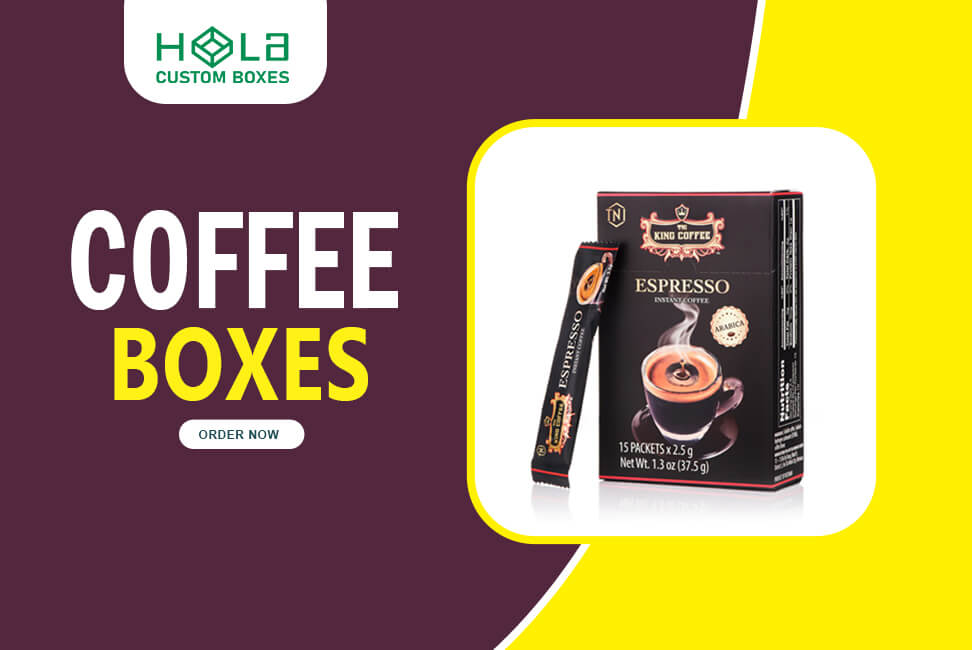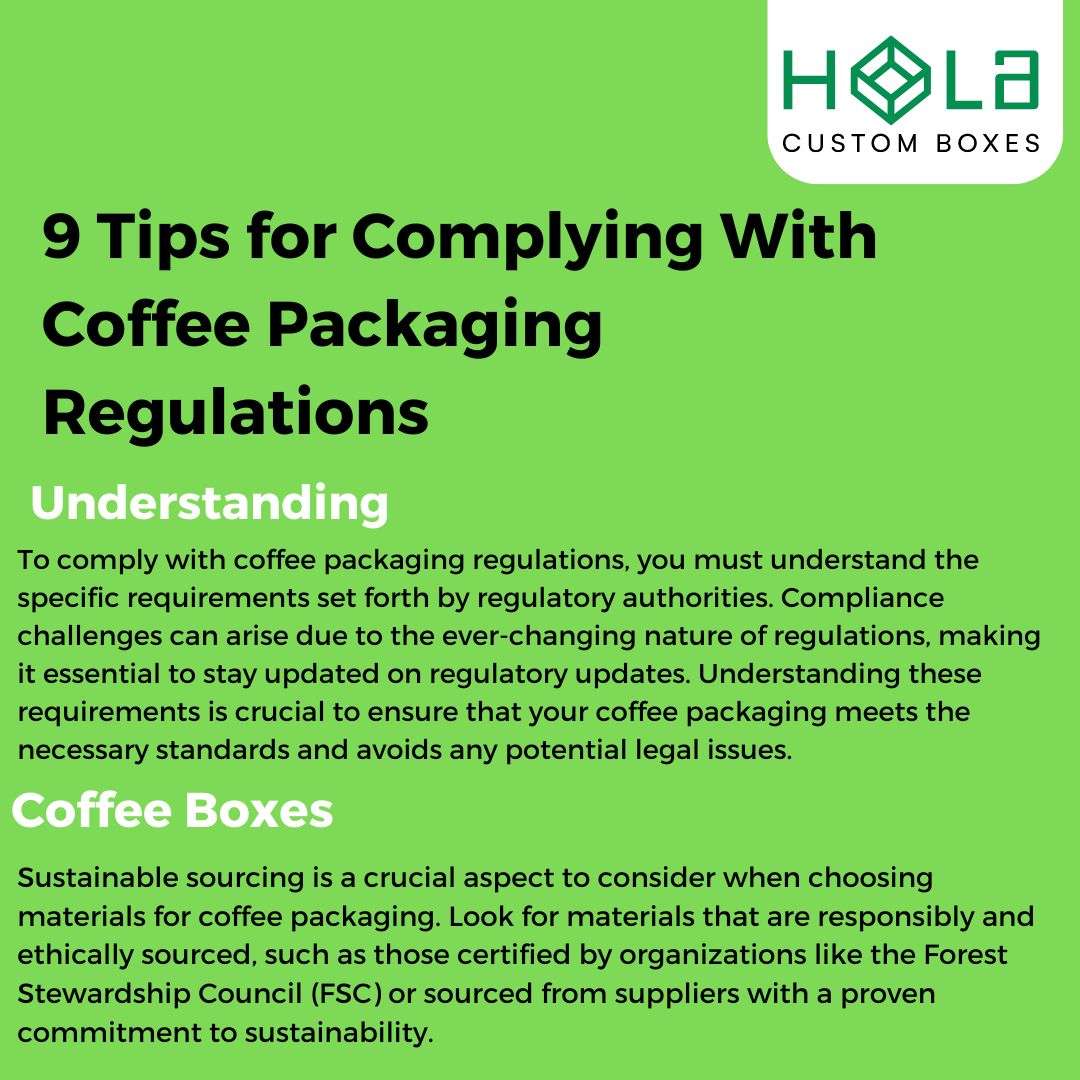9 Tips for Complying With Coffee Packaging Regulations
2025-11-25 17:01:20
Are you aware of the regulations surrounding coffee packaging?
Complying with these guidelines is crucial for ensuring the safety, quality, and legality of your product.
In this guide, we'll provide you with 9 essential tips for navigating the complexities of coffee packaging regulations.
From material selection to labeling requirements, understanding and adhering to these regulations is vital for the success of your coffee business.
So, let's dive in and explore the key considerations for packaging your coffee products.
Key Takeaways
- Prioritize sustainable sourcing and materials certified by organizations like FSC for coffee packaging
- Clearly list all ingredients and provide accurate nutritional information on coffee product labels
- Ensure packaging materials are safe for contact with food and clearly label any allergens present
- Implement rigorous quality control measures and collaborate with third-party quality assurance providers to maintain high quality and compliance with regulations for coffee packaging
Understanding Packaging Regulations

To comply with coffee packaging regulations, you must understand the specific requirements set forth by regulatory authorities. Compliance challenges can arise from the ever-changing nature of rules, making it essential to stay up to date. Understanding these requirements is crucial to ensuring your coffee packaging meets the required standards and avoids potential legal issues.
Compliance challenges often stem from the need to adapt to new regulations, which may involve adjustments to packaging materials, labeling, or manufacturing processes. Regulatory updates can impact various aspects of coffee packaging, including safety measures, environmental considerations, and consumer information requirements. Staying informed about these changes is vital for maintaining compliance and upholding the quality and integrity of your coffee products.
Transitioning into the subsequent section about 'material selection guidelines,' it's important to note that understanding packaging regulations is the foundation for making informed decisions about the materials used in coffee packaging. By being aware of compliance challenges and staying up to date on regulatory changes, you can effectively navigate the complexities of packaging regulations and make informed choices for your coffee packaging materials.
Sustainable Material Choices for Coffee Packaging
When selecting materials for coffee boxes, staying informed about regulatory updates and compliance standards is essential for making responsible decisions. Sustainable sourcing plays a key role—opt for materials that are ethically and responsibly obtained, such as those certified by the Forest Stewardship Council (FSC) or supplied by vendors with a strong track record in environmental stewardship. These choices not only meet industry standards but also enhance brand credibility.
Eco-Friendly Options for Reduced Environmental Impact
To minimize the environmental footprint of coffee packaging, prioritize eco-friendly materials, such as compostable or biodegradable options that naturally break down, reducing waste and pollution. Recyclable materials, especially those containing post-consumer recycled content, further support sustainability efforts. Aligning material choices with your brand’s environmental commitments not only protects the planet but also resonates with eco-conscious consumers.
Labeling Requirements For Custom Coffee Boxes
To comply with coffee packaging regulations, ensure your labeling meets the specific requirements set by the relevant authorities. When it comes to labeling your coffee products, there are certain key aspects that you need to focus on:
Ingredient Disclosure
Clearly list all the ingredients used in the coffee product. Make sure to follow any specific guidelines or restrictions set by the regulatory authorities regarding ingredient disclosure. This is crucial for consumers with allergies or dietary restrictions.
Nutritional Information
Provide accurate and complete nutritional information on the packaging. This includes details such as serving size, calories, fat content, and other relevant dietary components. Ensure that the format and content of the nutritional information comply with the regulations in your target market.
Safety and Health Regulations For Coffee Packaging
To comply with safety and health regulations, ensure that your coffee packaging meets the specific requirements and standards set by the relevant authorities. It's crucial to adhere to compliance standards and industry guidelines to ensure consumer safety and health.
When it comes to safety and health regulations, consider factors such as the packaging materials, potential allergens, and any specific handling instructions. Make sure your packaging materials are safe for food contact and free of any harmful chemicals. Additionally, clearly label any allergens present in the coffee product to prevent adverse reactions among consumers.
It's also essential to provide clear, accurate handling instructions to ensure the coffee is stored and prepared safely. By following these safety and health regulations, you can demonstrate your commitment to providing a product that meets the highest standards of quality and safety, thereby building trust with regulators and consumers alike.
Always stay up to date on any regulatory changes to ensure ongoing compliance and the continued safety of your coffee packaging.
Environmental Compliance Standards Of Coffee Packaging Boxes
Ensuring compliance with environmental standards for your coffee packaging involves minimizing waste and reducing the environmental impact of production processes. To achieve this, consider the following:
- Eco-Friendly Options
- Use compostable or biodegradable materials for your coffee packaging to minimize the environmental impact.
- Explore innovative packaging solutions such as reusable or refillable containers to reduce waste and promote sustainability.
By opting for eco-friendly options, you can significantly lessen the environmental footprint of your coffee packaging, demonstrating a commitment to sustainable practices.
Additionally, it's essential to integrate sustainable practices into your production processes. This can involve optimizing energy usage, reducing water consumption, and implementing efficient waste management systems. Embracing sustainable practices not only benefits the environment but also aligns with the growing consumer preference for eco-conscious products.
Transitioning from environmental compliance standards to packaging design considerations, it's vital to strike a balance between functionality, aesthetics, and ecological responsibility.
Coffee Packaging Design Considerations
To enhance your coffee packaging design, consider incorporating sustainable materials and functional yet visually appealing elements to align with environmental compliance standards.
Sustainability trends are crucial to packaging design considerations, as consumers increasingly prioritize eco-friendly products. Using recyclable or compostable materials, such as paper-based or biodegradable packaging, can appeal to environmentally conscious consumers while meeting regulatory requirements. Additionally, integrating functional elements, such as resealable zippers or easy-to-pour spouts, not only enhances consumer convenience but also adds value to the product.
Understanding consumer preferences is essential when designing coffee packaging. Researching and analyzing consumer behavior can provide valuable insights into visual elements that resonate with the target market. Whether it's minimalist designs, vibrant colors, or artisanal aesthetics, aligning the packaging with consumer preferences can significantly impact purchasing decisions.
Incorporating sustainable materials and appealing design elements into your coffee packaging not only helps you comply with regulations but also enhances your brand image. By staying attuned to sustainability trends and consumer preferences, you can create packaging that not only meets regulatory standards but also resonates with your target audience.
Quality Control Measures Of Custom-Printed Coffee Boxes
You can implement rigorous quality control measures to ensure that your coffee packaging complies with regulatory standards and meets consumer expectations. By incorporating thorough inspection procedures and adhering to packaging standards, you can maintain the quality and safety of your coffee products.
Internal Quality Checks:
Regularly conduct internal inspections of packaging materials to identify defects or inconsistencies that may compromise packaging integrity.
Implement a systematic quality control process within your production facility to monitor the packaging assembly line and identify any potential issues.
External Quality Assurance:
Collaborate with third-party quality assurance providers to conduct independent audits and inspections to verify that your packaging meets industry standards and regulatory requirements.
Establish clear communication channels with your packaging suppliers to ensure that they also adhere to strict quality control measures in their manufacturing processes.
Import and Export Regulations Of Coffee Boxes
Comply with import and export regulations by ensuring that your coffee packaging meets the specific requirements of each country you're shipping to or importing from. Customs clearance is a crucial aspect of international trade. Ensure your coffee packaging documentation is accurate and detailed to facilitate smooth customs clearance.
Each country has its own set of import and export regulations, so it's essential to stay informed and comply with these requirements to avoid any delays or complications. Additionally, consider any trade agreements that may affect the import and export of coffee packaging. Understanding and leveraging trade agreements can streamline the import and export processes, potentially reducing costs and simplifying compliance.
Keep a close eye on updates and changes to import and export regulations to ensure ongoing compliance and smooth international trade operations. By staying proactive and well-informed, you can navigate import and export regulations effectively and maintain a successful global coffee packaging business.
Compliance Documentation and Record-Keeping
Ensure your coffee packaging is accurately and thoroughly documented to maintain compliance with regulations and facilitate smooth customs clearance. Proper document management is crucial for meeting regulatory requirements. Here are some key points to consider:
Record-Keeping:
Keep all documentation related to your coffee packaging, including ingredient lists, production records, and quality control reports.
Ensure that these records are easily accessible and well-organized for audit preparation.
Document Management System:
Implement a robust document management system to store and track all packaging-related documents.
Regularly review and update your document management system to ensure it aligns with current regulations and standards.
Maintaining accurate and detailed records not only helps in complying with regulations but also streamlines the audit preparation process. By establishing effective document management practices, you can demonstrate transparency and accountability in your packaging processes.
This proactive approach not only ensures compliance but also contributes to the overall efficiency of your coffee packaging operations.
Conclusion
Now that you understand the regulations and guidelines for coffee packaging, you can ensure that your packaging is compliant and meets all necessary standards.
By following these tips, you can avoid potential fines and legal issues while also creating a safe and high-quality product for consumers.
Keep up with regulatory changes to stay ahead of the game and maintain compliance in the coffee packaging industry.
